Monday, October 30, 2006
To: Sol Re: sagely wisdom
March 18, 1965
Eva Hesse to Sol LeWitt:

"So I sit now after two days of working on a dumb thing which is three-dimensional. Supposed to be continuing with last drawing. ...but I don't know where I belong so I give up again. All the time it is like that...Everything for me personally is glossed with anxiety....How do you believe in something deeply? How is it one can pinpoint beliefs into a singular purpose?"
April 14, 1965
Sol LeWitt to Eva Hesse:

"You seem the same as always, and being you, hate every minute of it. Don't! Learn to say 'Fuck You' to the world once in a while. You have every right to. Just stop thinking, worrying, looking over your shoulder, wondering, doubting, fearing, hurting, hoping for some easy way out, struggling, gasping, confusing, itching, scratching, mumbling, bumbling, grumbling, humbling, stumbling, rumbling, rambling, gambling, tumbling, scumbling, scrambling, hitching, hatching, bitching, moaning, groaning, honing, boning, horse-shitting, hair-splitting, nit-picking, piss-trickling, nose-sticking, ass-gouging, eyeball-poking, finger-pointing, alleyway-sneaking, long-waiting, small-stepping, evil-eying, back-scratching, searching, perching, besmirching, grinding grinding grinding away at yourself. Stop it and just DO."
Eva Hesse to Sol LeWitt:

"So I sit now after two days of working on a dumb thing which is three-dimensional. Supposed to be continuing with last drawing. ...but I don't know where I belong so I give up again. All the time it is like that...Everything for me personally is glossed with anxiety....How do you believe in something deeply? How is it one can pinpoint beliefs into a singular purpose?"
April 14, 1965
Sol LeWitt to Eva Hesse:

"You seem the same as always, and being you, hate every minute of it. Don't! Learn to say 'Fuck You' to the world once in a while. You have every right to. Just stop thinking, worrying, looking over your shoulder, wondering, doubting, fearing, hurting, hoping for some easy way out, struggling, gasping, confusing, itching, scratching, mumbling, bumbling, grumbling, humbling, stumbling, rumbling, rambling, gambling, tumbling, scumbling, scrambling, hitching, hatching, bitching, moaning, groaning, honing, boning, horse-shitting, hair-splitting, nit-picking, piss-trickling, nose-sticking, ass-gouging, eyeball-poking, finger-pointing, alleyway-sneaking, long-waiting, small-stepping, evil-eying, back-scratching, searching, perching, besmirching, grinding grinding grinding away at yourself. Stop it and just DO."
Friday, October 27, 2006
Think Ink
The TD crew completed an inkjet print for an upcoming project. Inkjet printing, formerly called "giclee" - French for "spray" or "squirt" - has made its way forward from cheap, high-edition printing to unique, prestigious art. Justin Lowe's current show in Italy features several inkjet "paintings" on canvas; Peter Coffin exhibited an inkjet print of a newspaper ad in L.A.; Kelley Walker sold inkjet prints - and digital files - at Paula Cooper; Guyton/Walker did at Greene Naftali, too; Richard Prince's Nurse paintings; Jorge Pardo - and who can count the photographers making inkjet prints, the archival inks of which can outlast C-prints?
Of course, our project was an edition and not a unique product, which makes it like a deskilled print.
We started with a drawing on paper, 22" x 30." The final print would be on paper that size, although the printed area would be smaller. Our drawing was too big for a flatbed scanner; scanning each quarter and reassembling in Photoshop was a failure. Nothing lined up correctly. So a friend shot 35mm slides, which we thought we'd run through a slide scanner.
But it turns out that for our output dimensions, a 4x5" transparency would be more successful. We got one, took this to Duggal for a drum scan, and received a tiff file 7565 x 9963 pixels, which at 300 dpi means 215.6 MB! Big.
Then we went to see another friend who has a huge Epson printer, like as wide as an SUV. The seven prints took 2.5 - 3 hours, time killed with chocolate-covered pretzels, Stella Artois, and iTunes.
Of course, our project was an edition and not a unique product, which makes it like a deskilled print.
We started with a drawing on paper, 22" x 30." The final print would be on paper that size, although the printed area would be smaller. Our drawing was too big for a flatbed scanner; scanning each quarter and reassembling in Photoshop was a failure. Nothing lined up correctly. So a friend shot 35mm slides, which we thought we'd run through a slide scanner.
But it turns out that for our output dimensions, a 4x5" transparency would be more successful. We got one, took this to Duggal for a drum scan, and received a tiff file 7565 x 9963 pixels, which at 300 dpi means 215.6 MB! Big.
Then we went to see another friend who has a huge Epson printer, like as wide as an SUV. The seven prints took 2.5 - 3 hours, time killed with chocolate-covered pretzels, Stella Artois, and iTunes.
Tuesday, October 24, 2006
That's Saul, Folks!

The TD crew recalled a panel discussion with Peter Saul and Jim Nutt at Parsons last year, moderated by David Sandlin. Jim Nutt spoke measuredly and softly. Peter Saul, on the other hand, ranted and bellowed, chasing tangents and digressions. Apollonian Nutt was soft-spoken, offering placid reflections on his work, while Dionysian Saul was a rambunctious raconteur. Laughing, we couldn’t tell if he was serious, or just putting us on. Either way, he was hilarious, and seeing him made us like his work more.
Saul’s new work at Leo Koenig, Inc. proves us right about liking his work more and wrong about the Dionysian thing. The surfaces are smooth and unfettered and not gestural or frenetic. Controlled, planned, and dappled layers model his grotesque figures, and localized sheen on some darker colors proves the care with which he paints. He is crazy, but he’s a crazy craftsman.
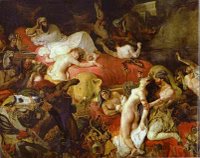

Typically heavy-handed, Saul takes on President Bush, relations with Islam, and identity crisis. "Sardanapalus" reworks the Delacroix masterpiece and conveys our perception of Islam as brutal, bad with women, and eventually self-destructive - all we need now is a portrait of Pope Benedict reading medieval texts. In "Bush at Abu Ghraib," the President grins next to a head turned to cottage cheese by bullets. And in "Self Portrait as a Woman," Saul's gender identity crisis reminds us of our rapidly improving awareness of men, women and those in between, and the roles they play. In the end, Saul proposes that interpersonal conflicts cause permanent changes, usually morbid, violent, and freakish. Saul’s existential commentary isn't forlorn or hopeless, however, and instead takes on an attitude of raucous self-deprecation and absurdity.
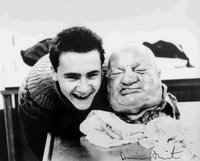
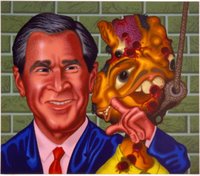
Monday, October 23, 2006
The Beacon Beckons

The TD crew embarked on an adventurous expedition to the Hudson hinterlands of Beacon. Popular demand brought an encore of Joan Jonas' performance, "The Shape, the Scent, the Feel of Things," so we seized the opportunity to experience it.
The site-specific, multi-media performance is inspired by Aby Warburg's writings and Jonas' "ongoing concern with the subject of ritual and performance." Indeed, she seemed like a witch doctor or shaman while drawing, dancing, and speaking.
Through interpretation of Warburg's writings and her own visits to the Hopi Indians, Jonas invokes Warburg's celebration of uncharted frontiers for its ability to foster man's essential needs - something the modern city can not do. Video segments and physical acts in "The Shape" evoke the relentless, meaningless clatter of industrialization; the excessively rapid, high-maintenance sprawl of cities; and the Sisyphian cycles of building and destroying civilizations. One segment presents desert landscape as an atmospheric site for meditation, then abruptly jumps to garish, flashing lights - Las Vegas - gaudy excess - while a fragile teepee is tossed about by the technological tempest. The piano accompaniment illustrates this violent upheaval. The suggestion is that Las Vegas, our bastion of entertainment and adventure, and a rapidly growing city, encroaches on the peaceful kingdom of the Natives. But Jonas doesn't stumble into a foolish Romanticism. Her video allows in some of the boredom inherent to the slow desert pace (though she excludes anything about the way Native American Reservations can profit from casinos).
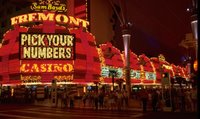
The dramatic climax ties everything together and opens up the Hudson River site as another layer of significance in the performance.

We would praise Jonas for tackling this physically demanding and ambitious project even at age 70, but we don't have to. Although age seems prerequisite to her wisdom; "The Shape" is a tremendous accomplishment for an artist of any age.
Epilogue:
Subterranean Sublime
The museum closed early for a VIP tour, so rather than leaving and having our full experience rent from our tender palms, we invited ourselves to join the tour. The highlight was getting to approach and then peer into Michael Heizer's holes, North, South, East, and West. We all laid on our stomachs to reduce our vulnerability of a misstep and subsequent bloody, mangled-up landing at the bottom.

Friday, October 20, 2006
Kings and Queens, Anima and Anime
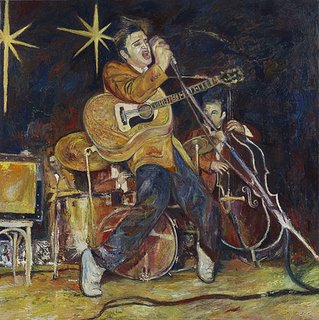
We are buzzing about Keith Mayerson's new show, Kings and Queens, opening tonight at Derek Eller. We are familiar with Keith's work, have seen him lecture, and even had a group crit with him. He teaches at NYU and SVA. When we write a book, he'll have a chapter. (We're pretty sure our over-eagerness gets on his nerves, despite his hippie/saint kindness, but we still like him.) Since around the year 2000, Keith's paintings have been idols - stars and scenes significant in pop culture - rendered in a soupy, gunky manner and muddy, pukey palette. His previous work has included abstract tunnels, "Pinocchio the Big Fag," and "Horror Hospital: Unplugged," with Dennis Cooper.

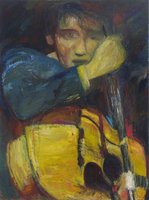
Keith funnels together semiotics, Jung, Warhol, Kilimnik, and Surrealism and Abexism:
With semiotics, he understands pop icons as symbols of the surrounding culture's appetite;
With Jung, these icons are archetypes and probably our collective Anima and Animus. Arch villains like Darth Vader are our shadow. And the many heroes - Robin Hood, Harry Potter, Princess Mononoke - employ Jung's concept of the Hero Myth. (We've also heard Keith praise Joseph Campbell). Keith's twist on this is to select many gay icons and divas - Judy Garland, Montgomery Clift, Rimbaud - cleverly confusing the gender-specificity of Jung's concept;
Jung also informs his painting style, driven by improvisation and intuition. Though he bases his paintings on photos, they brim with spontaneity and individuation, as if made from memory. So the pop image seems to have bubbled up from the collective unconscious, just as spooky creatures and orifices would bubble into an early surrealist, "Automatic" drawing by Pollock or Gorky;
Like Warhol, Keith uses the pop icon. But Keith does it to examine the needs of the culture. A culture celebrating Keanu Reeves as its champion is different than one celebrating John Wayne (see Hero Myth, above);

Kilimnik, Keith's kin, also mixes handwritten text and image, and renders pop figures in "bad" manner, as opposed to neat rendering and harmonious palettes, bypassing their glamour as a means to commenting on it. This takes us back to Pop Art, before it was shiny, glossy, and hard-edged; and instead messy, woody, and scrappy;
We mentioned Surrealism and AbEx painting because those artists tried to channel the collective unconscious into their work, or at least to abandon rationality and pursue irrational, intuitive approaches to their work.
Thus, Keith's iconography is actually our culture's iconography; his heroes are ours, despite the culture wars. We're waiting for a Village People painting.
In his past, Keith rocketed out of UC Irvine's grad program with the aforementioned "Pinocchio," a narrative about Pinocchio in a sexual crisis propelling him through a range of characters and places, almost like Dante's Inferno. His "Pet Paintings" were Soutine lite, expressively painted pups with hilarious twists, like a well-hung chihuahua. Other work brought him into prestigious places such as Jay Gorney, Luhring Augustine, and Mary Boone. "Illuminations" might be based on his return to Southern California, and how interesting to see those landscapes return in his "Forbidden Planet," 2002...

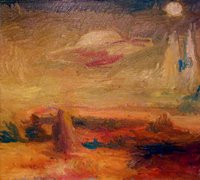
Anyway, why are we saying so much? Surely, you can see it yourself.
Wednesday, October 18, 2006
Elbow no!
Tuesday, October 17, 2006
Good Corners
The TD crew seriosly considered buying something at last night's k48 auction. We were convinced that it was among the most compelling images there. However, we were dissuaded by superficial damage. The corners were dented.
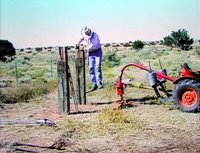

We recalled a friend telling us about a collector who reneged on buying a drawing because a corner was dented. He even admonished her to be more careful next time. But why? A painter working canvas can scratch and scrape with abandon. Rauschenberg sculpted junk, Basquiat drew on debris, and Warhol prints had everything from bullet holes to piss stains. Terrence Koh tried the piss thing, too. Duchamp's broken Large Glass. Hirst's shrinking shark. Hesse's decomposing rubber. And how about the Met's Duccio? Charred by votive candles. And certainly some Serras are seriously bloodstained.
The hand of the artist? The life of the object? Sometimes you leave a fingerprint. Sometimes sex stains sheets. (But that's no reason to turn down Natalie Portman or vintage River Phoenix.)
Anyway, we are still in the wake of dematerialization and Conceptual Art. So the art object is really just a demonstration or record of an art idea. Slight damage shouldn't matter. We should have bought it.



We recalled a friend telling us about a collector who reneged on buying a drawing because a corner was dented. He even admonished her to be more careful next time. But why? A painter working canvas can scratch and scrape with abandon. Rauschenberg sculpted junk, Basquiat drew on debris, and Warhol prints had everything from bullet holes to piss stains. Terrence Koh tried the piss thing, too. Duchamp's broken Large Glass. Hirst's shrinking shark. Hesse's decomposing rubber. And how about the Met's Duccio? Charred by votive candles. And certainly some Serras are seriously bloodstained.
The hand of the artist? The life of the object? Sometimes you leave a fingerprint. Sometimes sex stains sheets. (But that's no reason to turn down Natalie Portman or vintage River Phoenix.)
Anyway, we are still in the wake of dematerialization and Conceptual Art. So the art object is really just a demonstration or record of an art idea. Slight damage shouldn't matter. We should have bought it.

Monday, October 16, 2006
K48
The TD crew will be at the k48 party tonight. Scott Hug is raising funds to pay for fancy paper in the upcoming, sixth issue of his zine; so it's for a good cause!
Altruism aside, you'll see cool art, drink free beer and rock out to music by Michael Magnan, who notoriously kept the dance contest party at B Bar happenin for three years. (One time, we tried to breakdance on the floor, but while uprocking, stomped on a girl's foot. She shrieked and fled, and as we reached out to apologize, we accidentally knocked a fresh pint from a towering bloke's hand. He blamed someone else, and they started fighting. Bouncers rushed in, chaos! But that was years ago.)

Altruism aside, you'll see cool art, drink free beer and rock out to music by Michael Magnan, who notoriously kept the dance contest party at B Bar happenin for three years. (One time, we tried to breakdance on the floor, but while uprocking, stomped on a girl's foot. She shrieked and fled, and as we reached out to apologize, we accidentally knocked a fresh pint from a towering bloke's hand. He blamed someone else, and they started fighting. Bouncers rushed in, chaos! But that was years ago.)

Wednesday, October 11, 2006
Snow in October
The TD crew is a hung jury on Dash Snow's show at Rivington Arms.

The collages are weathered, assembled on yellowing paper and remnants of used books, some covered in dusty, second-hand frames. They include newspaper text, vintage porno pics, and weapons arranged in serpentine totems. The limited palette makes the images more iconic and sinister. However, they seem to carry a juvenile, priapic fixation on sex and weapons. The swastikas don't help. (Actually, we didn't count them, but sense that they were ubiquitous.) You probably knew someone in high school obsessed with knives, spiked bats, and Rotten dot com.
The assemblages are almost formless. Snow continues his book installations, first unveiled at the Whitney Biennial. The used paperbacks, about psychopaths, serial killers, satan-worshippers, and weirdos, are stacked in the back room as walls of a fort, with a blanket canopy hanging above. He's also used books as pedestals for vitrines containing more objects, and then there's the glass-covered box with hypodermic needles, boner-shaped lighters, knives, cigarette butts, and prescription medicine bottles (also recently used by Sarah Sze and Jean Shin). It's kind of like snooping in the desk drawer of a white-trash meth addict (or maker) and you can imagine him making a list of these transgressive trinkets.
Snow seems the anti-kitsch; everything is gross and rotting and severely wounded. But then it's all so easy and obvious, it becomes its own variety of kitsch. Thomas Hirschhorn's use of bullet-ridden bodies seems far more terrifying and poignant.
So what does it all mean? Snow fixates on and aggressively thrusts forward an underground/underbelly/viceland of sex and drugs and misanthropy, a world available only by the black market, dark alleys, and knowing where to look. Does the new work function like his Polaroids, as ambassadorial reportage from the fronts of drug-fueled parties and vandalism? Or is he simply searching out and pasting together shocking content, no better than Marilyn Manson? And how do we equate the bin Laden and Hitler imagery with the far less destructive drugs, guns, and porn? Or is this a critique of Bush's America, abrasive and aggressive only because it's, like, really frustrated?
We raise the questions but also hesitate because Dash Snow is a scenester. Here is Ryan McGinley's photo, "Dash Cutting Up Lines," and Dash Snow's response, a Polaroid of RMcG blowing lines off of a flaccid dick:


He boasts in interviews about parties and coke. (Of course, that could just be media manipulation.) He's a poster boy for AG jeans. (That could also be media manipulation.) He's a Menil. (Carlo McCormick claims that Snow never uses that familial connection, but can we really believe that?)

The collages are weathered, assembled on yellowing paper and remnants of used books, some covered in dusty, second-hand frames. They include newspaper text, vintage porno pics, and weapons arranged in serpentine totems. The limited palette makes the images more iconic and sinister. However, they seem to carry a juvenile, priapic fixation on sex and weapons. The swastikas don't help. (Actually, we didn't count them, but sense that they were ubiquitous.) You probably knew someone in high school obsessed with knives, spiked bats, and Rotten dot com.
The assemblages are almost formless. Snow continues his book installations, first unveiled at the Whitney Biennial. The used paperbacks, about psychopaths, serial killers, satan-worshippers, and weirdos, are stacked in the back room as walls of a fort, with a blanket canopy hanging above. He's also used books as pedestals for vitrines containing more objects, and then there's the glass-covered box with hypodermic needles, boner-shaped lighters, knives, cigarette butts, and prescription medicine bottles (also recently used by Sarah Sze and Jean Shin). It's kind of like snooping in the desk drawer of a white-trash meth addict (or maker) and you can imagine him making a list of these transgressive trinkets.
Snow seems the anti-kitsch; everything is gross and rotting and severely wounded. But then it's all so easy and obvious, it becomes its own variety of kitsch. Thomas Hirschhorn's use of bullet-ridden bodies seems far more terrifying and poignant.
So what does it all mean? Snow fixates on and aggressively thrusts forward an underground/underbelly/viceland of sex and drugs and misanthropy, a world available only by the black market, dark alleys, and knowing where to look. Does the new work function like his Polaroids, as ambassadorial reportage from the fronts of drug-fueled parties and vandalism? Or is he simply searching out and pasting together shocking content, no better than Marilyn Manson? And how do we equate the bin Laden and Hitler imagery with the far less destructive drugs, guns, and porn? Or is this a critique of Bush's America, abrasive and aggressive only because it's, like, really frustrated?
We raise the questions but also hesitate because Dash Snow is a scenester. Here is Ryan McGinley's photo, "Dash Cutting Up Lines," and Dash Snow's response, a Polaroid of RMcG blowing lines off of a flaccid dick:


He boasts in interviews about parties and coke. (Of course, that could just be media manipulation.) He's a poster boy for AG jeans. (That could also be media manipulation.) He's a Menil. (Carlo McCormick claims that Snow never uses that familial connection, but can we really believe that?)
Tuesday, October 10, 2006
Jackson Pollock game
We don't know if you've already seen this, but it's kept the TD crew consistently off task all day long. And boy are the bosses pissed!
http://www.jacksonpollock.org/
http://www.jacksonpollock.org/
Monday, October 09, 2006
Bercowetz & Bua Builders
Jesse Bercowetz and Matt Bua accumulate and assemble ramshackle, jheririgged structures from detritus. They are grotesque, awkward, and loaded with meaning.
Supporting these wretched arrangements are complex channels of history, conspiracy theory, and myth; and the architectural sites at which these narratives surface. For example, in "Can Jet Fuel Melt Steel?" a bowling ball perched atop a towering web of wooden skewers conveys skepticism about the collapsed World Trade Center towers. "Architectural Additions" hosts images, text, and an audio recording of David Nash, who tried to "occupy" Governor's Island for his imaginary, one-person political party. Nash sounds rational, if undereducated, and aware of the apparent craziness of his act - yet still convinced of its validity. Our analyst friend jokes, "The Neurotic builds castles in the sky; the Psychotic lives in them." Nash's theory about "king genes" is accompanied by a jingle about "king jeans."

Accumulation is the key to their process. The artists must have spent months in research: looking, absorbing, collecting, and filing information. Likewise, the range of materials involved suggests that they spent months (or years) combing through rubbish, storing it, and fishing it out later. There is a 1:1 ratio between research and materials. So "Raising the Dead," about Lazarus and sunken ships, is about itself as much as other things. The artists have resurrected discarded and forgotten objects - and ideas.

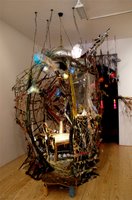
Another key is exposure. Like the conspiracies and myths exposed by their tellers, each structure's construction is fully exposed - trails of hot glue are as prominent as the kebab skewers they connect. Extension cords pile up. Nothing is hidden.

Formally, the artists fit (jam) into the "Clusterfuck Esthetic" coined by Jerry Saltz. And their typically male interest in history and conspiracy theory rounds up typically male-dominated legends. And how many men does it take to change a Bercowetz/Bua show? Still, their low-tech, pothead rubbish retreats from high-production clutterers like Mike Kelley and Jason Rhoades, and from architectural artists like Sarah Sze. In fact, they are the anti-Sze, because of their chaotic and anarchitectural structures, more like rusty exoskeletons than space-station map-o-zoids. Jon Kessler flaunted the kling-klang buzz and hum of thousands of TVs and miles of wires in his PS1 superproject, but Bercowetz/Bua use sound for interviews and music, viewer-activated via timer dials and played on second-hand boomboxes. "To Fry or Fly" is different - it's an overstimulation chamber in which the user can turn on a cacophony of senses-shattering alarms, like Jim Carrey's most annoying sounds in the world. Our sympathy to the gallery staff!
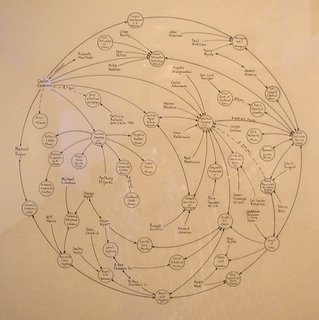
The late (offed?) Mark Lombardi designed dizzying maps of intercontinental exhanges and in-bed-with-the-devil partnerships including Western millionaires, the mob, Arab tycoons, and more - often exposing the market-driven, selective disapproval of terrorist funding. His text-based maps are modest as objects though abundant as carriers of information, owed to years of obsessive research. Lombardi splices the clues, editing indices of unlikely relationships. Bercowetz and Bua spend more time on a few individual events, and likewise spend more time on their complex structures. They are less like detectives, and more like curious, armchair journalists. But their output is almost masterful.
Supporting these wretched arrangements are complex channels of history, conspiracy theory, and myth; and the architectural sites at which these narratives surface. For example, in "Can Jet Fuel Melt Steel?" a bowling ball perched atop a towering web of wooden skewers conveys skepticism about the collapsed World Trade Center towers. "Architectural Additions" hosts images, text, and an audio recording of David Nash, who tried to "occupy" Governor's Island for his imaginary, one-person political party. Nash sounds rational, if undereducated, and aware of the apparent craziness of his act - yet still convinced of its validity. Our analyst friend jokes, "The Neurotic builds castles in the sky; the Psychotic lives in them." Nash's theory about "king genes" is accompanied by a jingle about "king jeans."

Accumulation is the key to their process. The artists must have spent months in research: looking, absorbing, collecting, and filing information. Likewise, the range of materials involved suggests that they spent months (or years) combing through rubbish, storing it, and fishing it out later. There is a 1:1 ratio between research and materials. So "Raising the Dead," about Lazarus and sunken ships, is about itself as much as other things. The artists have resurrected discarded and forgotten objects - and ideas.


Another key is exposure. Like the conspiracies and myths exposed by their tellers, each structure's construction is fully exposed - trails of hot glue are as prominent as the kebab skewers they connect. Extension cords pile up. Nothing is hidden.

Formally, the artists fit (jam) into the "Clusterfuck Esthetic" coined by Jerry Saltz. And their typically male interest in history and conspiracy theory rounds up typically male-dominated legends. And how many men does it take to change a Bercowetz/Bua show? Still, their low-tech, pothead rubbish retreats from high-production clutterers like Mike Kelley and Jason Rhoades, and from architectural artists like Sarah Sze. In fact, they are the anti-Sze, because of their chaotic and anarchitectural structures, more like rusty exoskeletons than space-station map-o-zoids. Jon Kessler flaunted the kling-klang buzz and hum of thousands of TVs and miles of wires in his PS1 superproject, but Bercowetz/Bua use sound for interviews and music, viewer-activated via timer dials and played on second-hand boomboxes. "To Fry or Fly" is different - it's an overstimulation chamber in which the user can turn on a cacophony of senses-shattering alarms, like Jim Carrey's most annoying sounds in the world. Our sympathy to the gallery staff!

The late (offed?) Mark Lombardi designed dizzying maps of intercontinental exhanges and in-bed-with-the-devil partnerships including Western millionaires, the mob, Arab tycoons, and more - often exposing the market-driven, selective disapproval of terrorist funding. His text-based maps are modest as objects though abundant as carriers of information, owed to years of obsessive research. Lombardi splices the clues, editing indices of unlikely relationships. Bercowetz and Bua spend more time on a few individual events, and likewise spend more time on their complex structures. They are less like detectives, and more like curious, armchair journalists. But their output is almost masterful.
Wednesday, October 04, 2006
Do it, Pruitt
Rob Pruitt, our great Phoenix, rose from the ashes of his 1992 Leo Castelli show, when, at 27, he and Walter Early crossed the Mason-Dixon line of Political Correctness with a seemingly racist show. Consequently, NYC exiled him for 7 years. (Looking back, this "misstep" turns out to be prescient and rich, now that Eminem is behind us and Kelley Walker sells racially sensitive work with no problem.) Later, Pruitt got revenge, salvation, and exposure with "Cocaine Buffet," a powder-propelled party and event at another artist's studio. Following that were the solo shows "101 Art Ideas You Can Do Yourself," "Pandas and Bamboo," and many group shows. Panda paintings in the 2004 Biennial cemented his complete comeback.

The new show is more Home Depot than Pearl Paint, as Pruitt uses construction materials like poured cement and foil-covered insulation. And he uses repetition in the self-sufficient sculptures, like in the radiating can-can dancers. Construction materials? Repetition? No pedestals? Sounds like minimalism. And it is! But instead of impenetrable, glossy surfaces of steel, his sculptures are crusty concrete and aged denim. They are casual, vernacular, and "slacker," rather than formal, systematic, and "ideologue." They're a cool dude (or chick) chilling on the beach, miles away from an ivory tower and math books, probably snacking on potato chips from a Kevin Landers sculpture. Doubt it? How about "Minimalist Sculpture for My Dad," a sculpture shown last year at Nicole Klagsbrun, which Roberta Smith claimed "contrasts weight and featherweight, butch and femme, with a Juddian plywood box." And it was covered with potato chips!

Minimalism is infamous for its macho rigidity and austerity. And so is AbEx painting, another theme addressed by Pruitt. He's taking the most manly methods and castrating them. Vintage denim is often sold unisex, and anyway, these legs are gender-free. And the paintings are almost Liberace, dressed in flamboyant pink and dazzling silver. Mixing glitter into the paint crystallizes how gay these paintings really are; this is magnified by their large scale. Using the mural proportions of AbEx painting and its broad, bold gestures, Pruitt simultaneously subverts that school of painting. With the gauche glitter and puffed-up palette, the entire thing becomes a gaudy disaster, mocking the self-important pretenses of action painting.

The sculptures allude to the body, as well. One knows by looking that the cement is heavy, which emphasizes the weight of these sculptures. They aren't just space. They would make an impression in your bed. Felix Gonzalez-Torres also tuned into the importance of weight; some of his candy sculptures were amassed according to the weight of Ross, his lover and inspiration. Pruitt's viewers will ride the jeans to a place where the sculptures seem to have personality, self, and familiarity. Everyone owns jeans, and probably does fun things in them on the weekend. Warhol spoke of Levi's 501s as the perfect attire for a young person.
Some of these materials also stir up Pruitt's own history. He used denim in some early work with Early, and he may have picked up the insulation idea while customizing his headlining house upstate, also a topic in a 2003 show.


The new show is more Home Depot than Pearl Paint, as Pruitt uses construction materials like poured cement and foil-covered insulation. And he uses repetition in the self-sufficient sculptures, like in the radiating can-can dancers. Construction materials? Repetition? No pedestals? Sounds like minimalism. And it is! But instead of impenetrable, glossy surfaces of steel, his sculptures are crusty concrete and aged denim. They are casual, vernacular, and "slacker," rather than formal, systematic, and "ideologue." They're a cool dude (or chick) chilling on the beach, miles away from an ivory tower and math books, probably snacking on potato chips from a Kevin Landers sculpture. Doubt it? How about "Minimalist Sculpture for My Dad," a sculpture shown last year at Nicole Klagsbrun, which Roberta Smith claimed "contrasts weight and featherweight, butch and femme, with a Juddian plywood box." And it was covered with potato chips!

Minimalism is infamous for its macho rigidity and austerity. And so is AbEx painting, another theme addressed by Pruitt. He's taking the most manly methods and castrating them. Vintage denim is often sold unisex, and anyway, these legs are gender-free. And the paintings are almost Liberace, dressed in flamboyant pink and dazzling silver. Mixing glitter into the paint crystallizes how gay these paintings really are; this is magnified by their large scale. Using the mural proportions of AbEx painting and its broad, bold gestures, Pruitt simultaneously subverts that school of painting. With the gauche glitter and puffed-up palette, the entire thing becomes a gaudy disaster, mocking the self-important pretenses of action painting.

The sculptures allude to the body, as well. One knows by looking that the cement is heavy, which emphasizes the weight of these sculptures. They aren't just space. They would make an impression in your bed. Felix Gonzalez-Torres also tuned into the importance of weight; some of his candy sculptures were amassed according to the weight of Ross, his lover and inspiration. Pruitt's viewers will ride the jeans to a place where the sculptures seem to have personality, self, and familiarity. Everyone owns jeans, and probably does fun things in them on the weekend. Warhol spoke of Levi's 501s as the perfect attire for a young person.
Some of these materials also stir up Pruitt's own history. He used denim in some early work with Early, and he may have picked up the insulation idea while customizing his headlining house upstate, also a topic in a 2003 show.

Monday, October 02, 2006
A Guy Called Gerald
Don't look back in anger, Gerald Davis. Your nostalgia is tainted by resentment, fear, and victimhood. Indeed, you must have felt so helpless against the fear of death. Late Cold War paranoia, death in the family, and acknowledging your fragile physiology made you so vulnerable, it's no wonder that your drawings are so tender, despite the formal restrictions you impose: monochrome, diptych format, obsessive rendering, and nice, big paper.

You relish some cultural, historical signifiers, like the "Vuarnet France" logo, E.T. and LaCoste polo knits. But most of your memories are darker. Other kids bully you by pushing you in a closet and writing "Fag Boy" on your chest; a family member scrutinizes and condemns your joy in Disney animation; your Grandmother passes away; you get lost in the woods; your body feels absurd and exposed; Armageddon arrives and people are processed in a fiery, intestinal hell. Your apocalyptic outlook belies your youthful innocence. "How can someone so young, say words so sad?" sang Morrissey.


This end-of-the-world obsession fuels "Watching 'Testament,'" the 1983 film about nuclear armageddon. You remember yourself watching the film and relating to Scottie Wetherly, fatally ill from radiation. Horrific demons slither and ooze between your thoughts and organs. You understand your mortality, which makes the film so poignant, and you understand the film, which makes your mortality so terrifying. A vicious cycle.
Has it gotten any better?
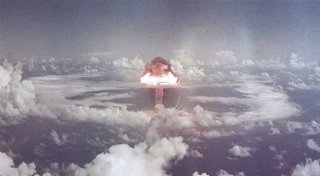

You relish some cultural, historical signifiers, like the "Vuarnet France" logo, E.T. and LaCoste polo knits. But most of your memories are darker. Other kids bully you by pushing you in a closet and writing "Fag Boy" on your chest; a family member scrutinizes and condemns your joy in Disney animation; your Grandmother passes away; you get lost in the woods; your body feels absurd and exposed; Armageddon arrives and people are processed in a fiery, intestinal hell. Your apocalyptic outlook belies your youthful innocence. "How can someone so young, say words so sad?" sang Morrissey.


This end-of-the-world obsession fuels "Watching 'Testament,'" the 1983 film about nuclear armageddon. You remember yourself watching the film and relating to Scottie Wetherly, fatally ill from radiation. Horrific demons slither and ooze between your thoughts and organs. You understand your mortality, which makes the film so poignant, and you understand the film, which makes your mortality so terrifying. A vicious cycle.
Has it gotten any better?


